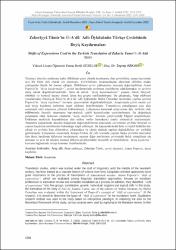| dc.contributor.author | Güzeler, Fatma Betül | |
| dc.contributor.author | Arkan, Zeynep | |
| dc.date.accessioned | 2023-09-06T12:35:28Z | |
| dc.date.available | 2023-09-06T12:35:28Z | |
| dc.date.issued | 29.12.2022 | en_US |
| dc.identifier.citation | Güzeler, F. B. & Arkan, Z. (2022). Zekeriyyâ Tâmir’in El-Aʿdâʾ Adlı Öyküsünün Türkçe Çevirisinde Deyiş Kaydırmaları . Afyon Kocatepe Üniversitesi Sosyal Bilimler Dergisi , 24 (4) , 1241-1252 . DOI: 10.32709/akusosbil.1032706 | en_US |
| dc.identifier.uri | https://dergipark.org.tr/tr/pub/akusosbil/issue/74315/1032706 | |
| dc.identifier.uri | https://hdl.handle.net/11630/10736 | |
| dc.description.abstract | Yirminci yüzyılın ortalarına kadar dilbilimin çatısı altında incelenmiş olan çeviribilim, zaman içerisinde ayrı bir bilim dalı olarak ele alınmıştır. Çeviribilimin kuramsallaşma sürecinde dilbilim odaklı yaklaşımlar büyük bir öneme sahiptir. Dilbilimsel çeviri yaklaşımları arasında değerlendirilen Anton Popovič‟in “deyiş kaydırmaları”, çeviri incelemesinde çevirmen tercihlerine odaklanmakta ve çeviriyi süreç olarak değerlendirmektedir. Buna ek olarak “deyiş kaydırmalarını” yapısal, türsel, bireysel, olumsuz ve konusal kayma olmak üzere beş grupta sınıflandırmıştır. Bu çalışmada, Arap edebiyatı yazarlarından Zekeriyyâ Tâmir‟in el-Aʿdâʾ adlı öyküsünün Halim Öznurhan tarafından yapılan çevirisi Popovič‟in “deyiş kaydırma” kavramı çerçevesinde değerlendirilmiştir. Araştırmada çeviri eserde yer alan deyiş kaydırma türlerinin tespit edilmesi hedeflenmiştir. Yorumlayıcı paradigmayı esas alan çalışmada nitel araştırma yöntemi kullanılmıştır. Çalışmanın kuramsal çerçevesine dair verilerin elde edilmesinde literatür taramasına başvurularak çeşitli kaynaklardan yararlanılmıştır. Bu doğrultuda çalışmanın odak noktasını oluşturan “deyiş kaydırma” kavramı çerçevesinde bilgiler araştırılmıştır. Doküman analiziyle kaynaklardan elde edilen veriler betimleyici analiz yöntemiyle incelenmiştir. Araştırma kapsamında ulaşılan bulguların değerlendirilmesi sonucunda çevirmenin çeviride bireysel ve yapısal kaydırma tercihlerinin bulunduğu tespit edilmiştir. Bu kapsamda hedef kitle ve hedef kültürün öne çıktığı ve çeviride bazı eklemelere, çıkarmalara ve cümle türünde yapılan değişikliklere yer verildiği gözlenmiştir. Çalışmanın sonucunda Arapça-Türkçe dil çifti arasında yapılan başka çeviriler üzerinden tüm deyiş kaydırma türlerinin incelenmesi, yazarın diğer eserlerinin çevirisinde farklı stratejilerin ele alınması ve aynı dil ailesine mensup dillerin çevirilerindeki benzerlik ve farklılıkların “deyiş kaydırma” kavramı bağlamında ortaya konması önerilmektedir. | en_US |
| dc.description.abstract | Translation studies, which was studied under the roof of linguistics until the middle of the twentieth century, has been treated as a separate branch of science over time. Linguistic-oriented approaches have great importance in the process of theorization of translational science. Anton Popovič‟s “shift of expressions”, which are evaluated among linguistic translation approaches, focuses on translator preferences in translation review and considers translation as a process. In addition, they classified “shift of expressions” into five groups: constitutive, generic, individual, negative and topical shift. In this study, the translation of the story al-Adâ by Zakaria Tamer, one of the authors of Arabic literature, by Halim Öznurhan was evaluated within the framework of Popovič‟s concept of “shift of expression”. In the research, it is aimed to determine the types of “shift of expression” in the translation work. Qualitative research method was used in the study based on interpretive paradigm. In obtaining the data on the theoretical framework of the study, various sources were used by applying to the literature review. In this direction, information was investigated within the framework of the concept of “shift of expression”, which constitutes the focus of the study. The data obtained from the sources with document analysis were examined by descriptive analysis method. As a result of the evaluation of the findings reached within the scope of the research, it was determined that the translator had individual and constitutive shift preferences in the translation. In this context, it has been observed that the target audience and target culture stand out and that some additions, subtractions and changes to the sentence type are included in the translation. As a result of the study, it is recommended to examine all types of shift of expression through other translations between the Arabic-Turkish language pair, to examine different strategies in the translation of other works of the author, and to reveal the similarities and differences in translations of languages belonging to the same language family in the context of the concept of “shift of expression”. | en_US |
| dc.language.iso | tur | en_US |
| dc.publisher | Afyon Kocatepe Üniversitesi | en_US |
| dc.identifier.doi | 10.32709/akusosbil.1032706 | en_US |
| dc.rights | info:eu-repo/semantics/openAccess | en_US |
| dc.subject | Arap Dili | en_US |
| dc.subject | Arap Edebiyatı | en_US |
| dc.subject | Zekeriya Tamir | en_US |
| dc.subject | Çeviri Eleştirisi | en_US |
| dc.subject | Anton Popovic | en_US |
| dc.subject | Deyiş Kaydırma | en_US |
| dc.subject | Arabic Language | en_US |
| dc.subject | Arabic Literature | en_US |
| dc.subject | Zakaria Tamer | en_US |
| dc.subject | Translation Criticism | en_US |
| dc.subject | Anton Popovic | en_US |
| dc.subject | Shift of Expression | en_US |
| dc.title | Zekeriyyâ Tâmir’in El-Aʿdâʾ adlı öyküsünün Türkçe çevirisinde deyiş kaydırmaları | en_US |
| dc.title.alternative | Shifts of expressions used in the Turkish translation of Zakaria Tamer’s Al-Adâ story | en_US |
| dc.type | article | en_US |
| dc.relation.journal | Afyon Kocatepe Üniversitesi Sosyal Bilimler Dergisi | en_US |
| dc.department | Seçiniz | en_US |
| dc.authorid | 0000-0003-2837-8876 | en_US |
| dc.authorid | 0000-0003-0534-186X | en_US |
| dc.identifier.volume | 24 | en_US |
| dc.identifier.startpage | 1241 | en_US |
| dc.identifier.endpage | 1252 | en_US |
| dc.identifier.issue | 4 | en_US |
| dc.relation.publicationcategory | Makale - Ulusal Hakemli Dergi - Başka Kurum Yazarı | en_US |



















